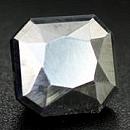|
|
||||||||||||||||
|
||||||||||||||||
|
||||||
|
|
|
|
Arsenic
|
|
| | |
| Discovered in ancient times; IMA status: Valid (pre-IMA; Grandfathered) | ||
|
| ||
|
Chemistry |
|
|
| |
|
As | |
|
|
Arsenic (native element) |
|
Molecular Weight: |
74.92 gm |
|
Composition: |
Arsenic |
100.00 % |
As |
|
|
|
|
|
100.00 % |
|
|
|
|
|
|
||||
|
Classification |
|
|
| |
|
Elements | |
|
1/B.01-10 | |
|
|
1 : ELEMENTS (Metals and intermetallic alloys; metalloids and nonmetals; carbides, silicides, nitrides, phosphides)
|
|
Related to: |
Arsenic Group. Dimorph of Arsenolamprite. |
|
Members of Group: |
Arsenic Group: Antimony, Arsenic, Bismuth |
|
Varieties: |
None |
|
Synonyms: |
Löffelkobalt, Native Arsenic |
|
|
|
|
Crystal Data |
|
|
|
|
|
Commonly granular, massive, and in concentric layers; may be reticulated, reniform, stalactitic; rarely columnar or acicular; also as rhombohedra, to 1 mm. |
|
|
Rare on twin plane {1014}; pressure twinning on {0112} develops delicate lamellae. |
|
|
|
|
|
Physical Properties |
|
|
|
|
|
Perfect on {0001}, fair on {1014} |
|
|
Irregular/Uneven |
|
|
Brittle |
|
|
3.5 |
|
|
Vicker's Hardness: |
VHN100=1081 (kg/mm2) |
|
2.74 - 2.95 (g/cm3) |
|
|
Fluoresces violet under LW UV. |
|
|
Not Radioactive |
|
|
Health Warning: |
CAUTION: Contains Arsenic, a poisonous element - always wash hands after handling. Avoid inhaling dust when handling or breaking. Never lick or ingest. |
|
|
|
|
Optical Properties |
|
|
|
|
|
Tin-white, tarnishes to dark gray |
|
|
Transparent to Translucent |
|
|
Metallic, sub-metallic, dull |
|
|
R1–R2: (400) 56.0–57.5, (420) 55.1–56.8, (440) 54.2–56.2, (460) 53.3–55.8, (480) 52.7–55.7, (500) 52.4–55.7, (520) 52.0–55.7, (540) 51.7–55.7, (560) 51.5–55.6, (580) 51.2–55.4, (600) 51.0–55.2, (620) 50.8–55.0, (640) 50.6–54.9, (660) 50.5–54.8, (680) 50.4–54.7, (700) 50.4–54.6 |
|
|
0.00 (opaque) |
|
|
n/a |
|
|
Weak |
|
|
Distinct; yellowish brown and light gray to yellowish gray. |
|
|
|
|
|
Occurances |
|
|
|
|
|
Geological Setting: |
In hydrothermal veins and deposits that contain other arsenic minerals; may be in Co–Ag sulfide veins. |
|
Common Associations: |
Arsenolite, Cinnabar, Realgar, Orpiment, Stibnite, Galena, Sphalerite, Pyrite, Barite |
|
Common Impurities: |
Bi, Sb, Fe, Ni, Ag, S, Se |
|
Type Locality: |
Unknown |
|
Year Discovered: |
Discovered in ancient times |
|
View mineral photos: | |
|
|
|
|
More Information |
|
|
|
|
|
| |
|
|
|
|
Arsenic belongs to the Arsenic Group of minerals that includes Antimony, Arsenic and Bismuth. Arsenic is a native element. Native element minerals are elements that occur in nature uncombined with other elements and with a distinct mineral structure. A native element is a pure chemical substance consisting of a single type of atom. Arsenic has only arsenic (As) atoms as opposed to a mineral such as Quartz that has two types of atoms; silicon (Si) and oxygen (O) or other more complex minerals that contain many types of atoms. Elements are divided into metals, metalloids and nonmetals. Arsenic is a metalloid which means it is an element that has properties between the typical metals and nonmetals. The six commonly recognised metalloids are antimony, arsenic, boron, germanium, silicon and tellurium. Elements less commonly recognised as metalloids include aluminium, astatine, carbon, polonium and selenium. Arsenic does not often form in its elemental state and is far more common as a component in sulfides and sulfosalts such as Arsenopyrite, Orpiment, and Realgar. Native Arsenic is found in silver ore veins and is processed along with the silver ore. Native Arsenic is usually found to have a trigonal symmetry but a very rare orthorhombic arsenic is known from Saxony, Germany and is named Arsenolamprite. The two minerals are called polymorphs (meaning many shapes) because they have the same chemistry but different structures. Distribution:
Numerous localities are known, most of only minor interest.
In Germany, from Freiberg, Schneeberg, Johanngeorgenstadt,
Marienberg, and Annaberg, Saxony; Wolfsberg and St.
Andreasberg, Harz Mountains; and Wieden, Black Forest.
In the Gabe-Gottes mine, Rauenthal, near Sainte-Marie-aux-Mines,
Haut-Rhin, France. At Jáchymov (Joachimsthal),
Príbram, and Cínovec (Zinnwald), Czech
Republic. In Romania, from Sacarîmb (Nagyág),
Hunyad, and Cavnic (Kapnikbánya). At Sterling
Hill, Ogdensburg, Sussex County, New Jersey and Washington
Camp, Santa Cruz County, Arizona, USA. In the Huallapón
mine, Pasto Bueno, Ancash Province, Peru. At Bidi, Sarawak
Province, Borneo. In the Akatani mine, Fukui Prefecture,
Japan. From the Dajishan tungsten deposits, Jianxi Province,
China. |
|
|
We
have not photographed our Arsenic
gems yet. Please
check back soon. |
